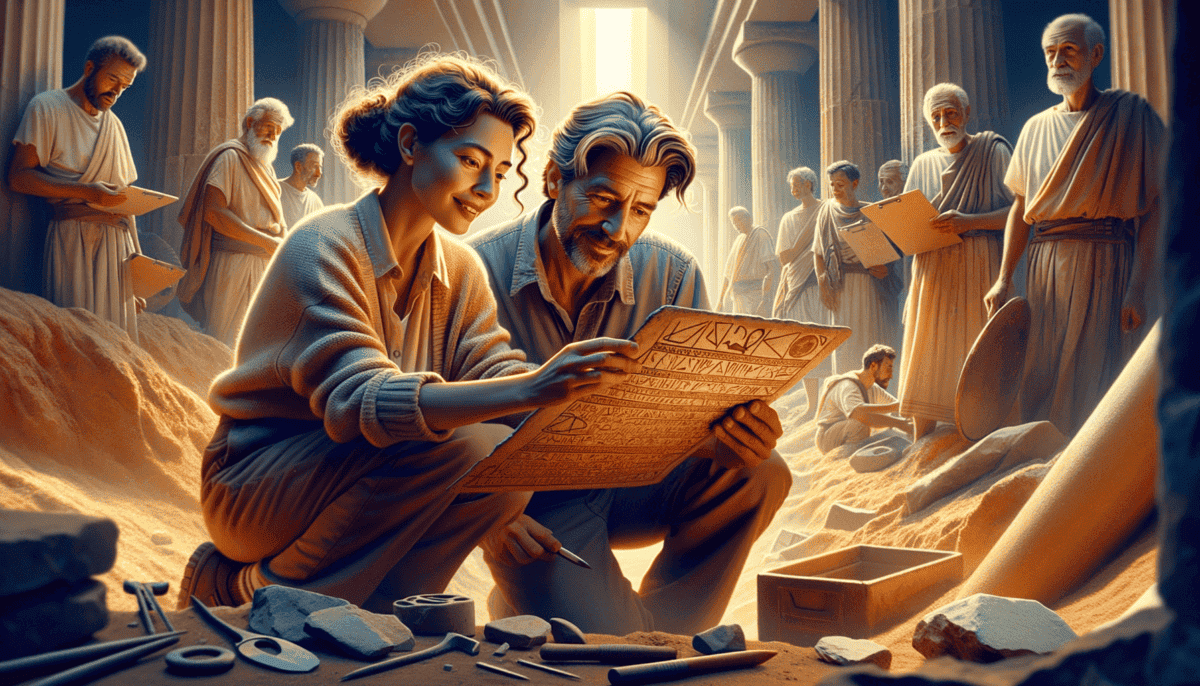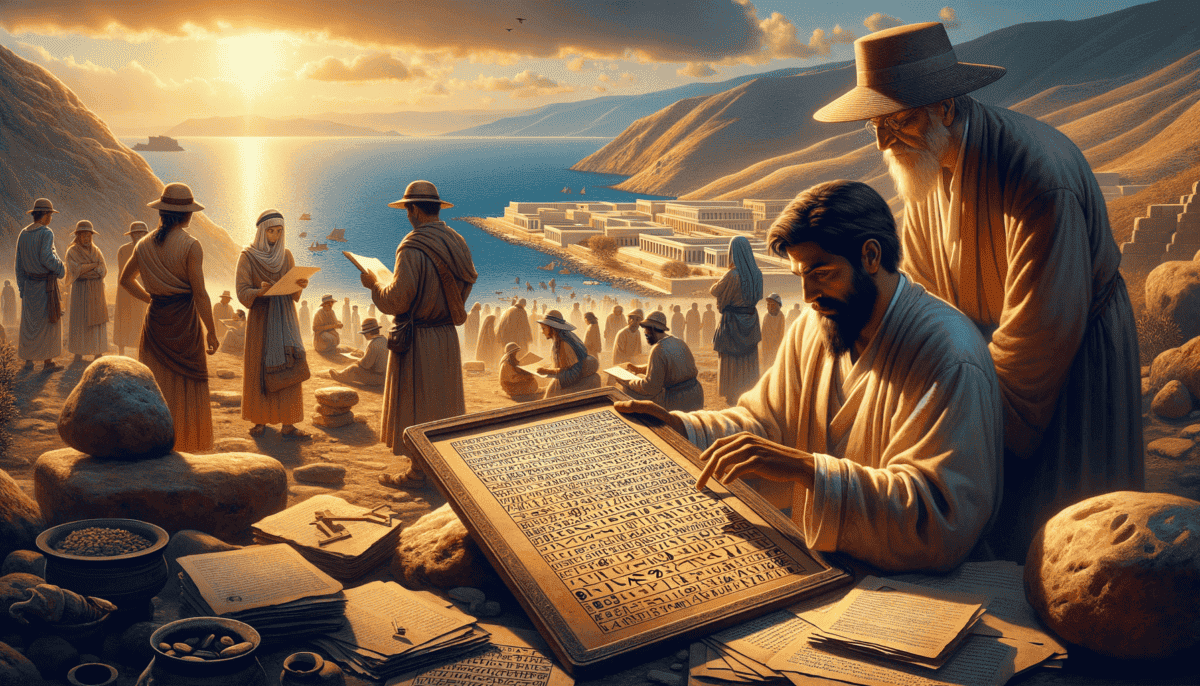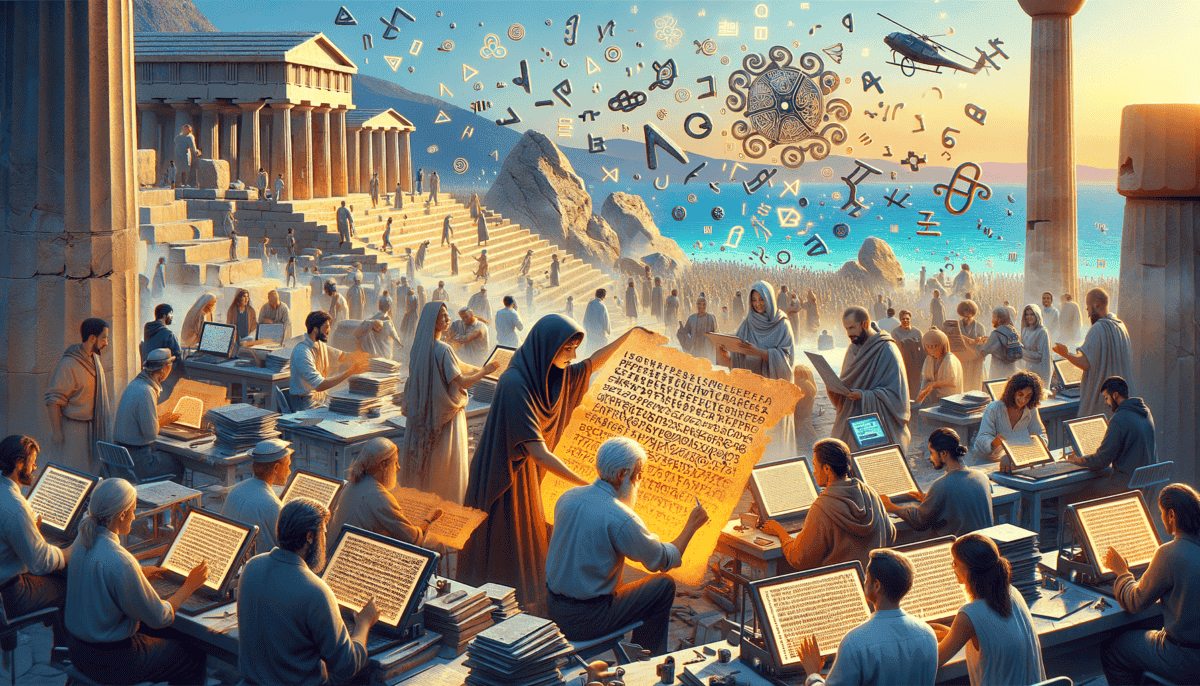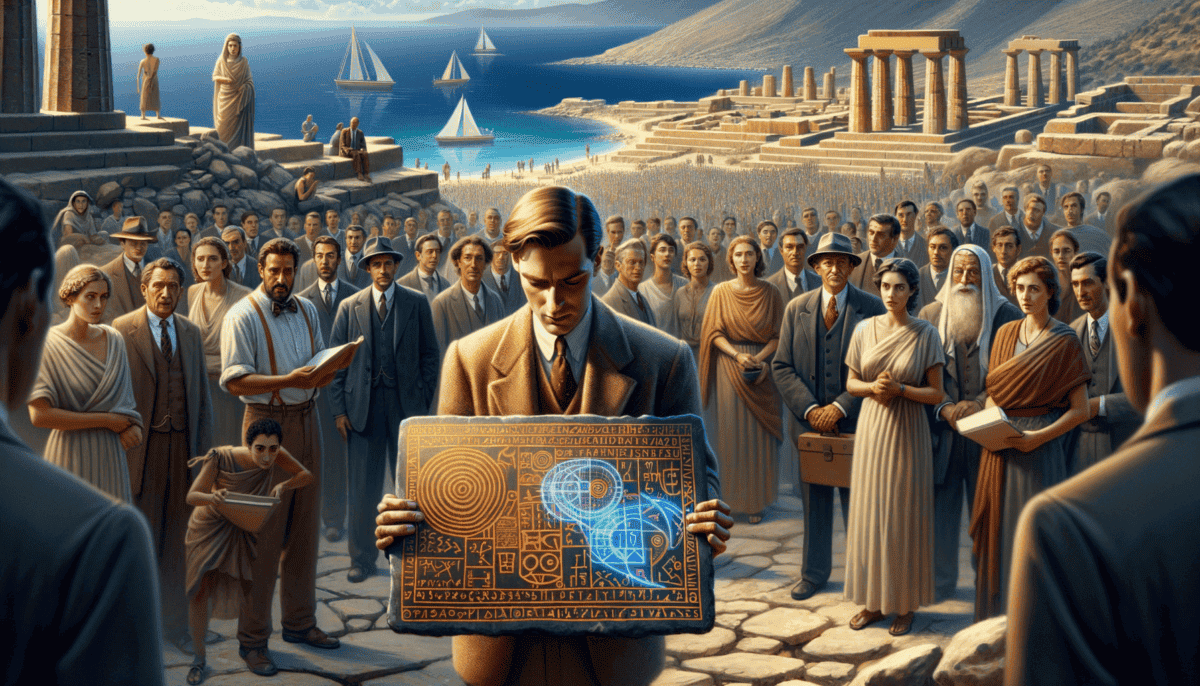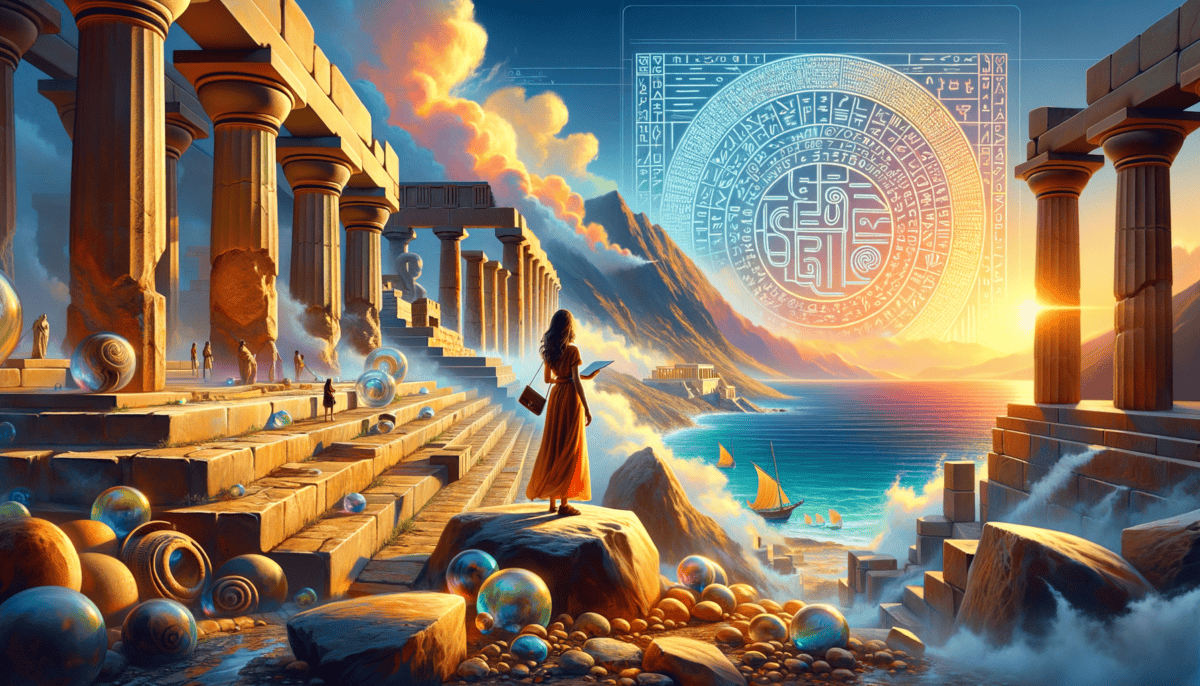The Hidden Tablets
Sara pressed her face against the airplane window, watching the island of Crete grow bigger and bigger. The blue sea sparkled below like a million tiny diamonds. At just 8 years old, this was her first big adventure, and she could hardly sit still.
"Look, Mom! Is that where we're going?" Sara pointed excitedly at the rocky coastline coming into view.
Her mother, Dr. Maria Chen, smiled and nodded. "That's right, sweetie. The Palace of Knossos is waiting for us down there."
As they drove from the airport, Sara saw hills covered with olive trees and old stone buildings. The air smelled like sea salt and herbs. Their van bounced along the dusty road until they reached a huge archaeological site.
"Wow!" Sara gasped. Ancient stone walls stretched out before her. Some were taller than houses!
Dr. Chen led Sara to a special tent where other scientists were working. Inside, people bent over tables, looking at something very carefully through magnifying glasses.
"What are they looking at?" Sara whispered.
"These are very special clay tablets," her mother explained, picking up one carefully with gloved hands. "They're like ancient letters, but we can't read them yet. They have mysterious symbols that no one understands."
Sara leaned in close. The tablet was flat and brown, about the size of her hand. Tiny marks were scratched into its surface in neat rows. They looked like little pictures mixed with lines and curves.
"That's right! These marks are called Linear A. They were made by people called the Minoans, who lived here thousands of years ago." Dr. Chen carefully placed the tablet back on the table.
Sara watched as more tablets were brought in from the dig site. Each one was cleaned very gently with small brushes. The scientists took pictures and made drawings of every mark.
"But why can't anyone read them?" Sara asked, tracing the strange symbols in the air with her finger.
"Well, honey, that's the big mystery. These people disappeared so long ago that their language was forgotten. It's like trying to read an alien message – we can see the writing, but we don't know what it means."
That night, lying in her cot in the research camp, Sara couldn't stop thinking about the mysterious tablets. The warm Mediterranean breeze carried the smell of sage through her tent, and crickets chirped outside.
As she drifted off to sleep, Sara dreamed of the people who had written those messages so long ago. What secrets were they sharing? What stories were they telling? Tomorrow would bring new discoveries, and Sara couldn't wait to learn more.
“Every tablet is like a window into the past,” her mother had said. “We just need to figure out how to open it.”
Outside, the ancient stones of Knossos stood silent under the starlight, still keeping their secrets after thousands of years. But maybe, just maybe, they were waiting for someone like Sara to help unlock their mysteries.
The Archaeological Adventure
The morning sun was just peeking over the hills when Sara heard excited voices outside her tent. She rushed out, still in her pajamas, to find everyone gathering around a tall man with a big mustache and a fancy hat.
“Who’s that?” Sara whispered to her mother.
“That’s Sir Arthur Evans,” Dr. Chen explained. “He’s the famous archaeologist who first found these ruins over a hundred years ago. Today, we’re going to retrace his footsteps!”
Sara followed the team to a new digging site. Everyone had special tools – small brushes, tiny shovels, and measuring tapes. Her mother gave her a special junior archaeologist kit with her very own brush and magnifying glass.
“Remember,” Dr. Chen said, “we dig very slowly and carefully. Everything we find tells us a story about the past.”
As the sun climbed higher, Sara helped brush dirt away from old stones. Suddenly, her brush hit something hard and flat.
Dr. Chen hurried over. Together, they carefully uncovered a clay tablet, just like the ones from yesterday. But this one looked different.
“Look at these symbols,” her mother pointed. “These are Linear B – they’re a bit different from Linear A. See how the lines are more angular?”
“It’s like they used two different kinds of writing?” Sara asked, squinting through her magnifying glass.
“Exactly! The Minoans used Linear A first. Then came the Mycenaean people, who used Linear B. It’s like having two different puzzles to solve!”
During lunch break, Sara sat with Dr. Rodriguez, who showed her how they make copies of the tablets.
“We take pictures and make drawings,” he explained. “Then we can study them without damaging the real tablets. They’re very fragile – like cookies that have been sitting out for 4,000 years!”
Sara giggled at the comparison. She watched as the team measured and documented every new finding. Some tablets had marks that looked like wheat. Others had shapes like sheep or pots.
As the afternoon went on, Sara’s excitement grew. She imagined Arthur Evans standing in this same spot, feeling the same thrill of discovery. What was it like for him to find these mysterious messages for the first time?
Her mother found her making her own tablet in the soft dirt with a stick.
“What are you writing?” Dr. Chen asked with a smile.
“I’m making my own Linear A message,” Sara replied. “It says ‘Today I became an archaeologist!'”
The sun was setting over the ancient walls of Knossos, painting them orange and gold. Tomorrow would bring more digging, more discoveries, and maybe – just maybe – more clues to help solve the mystery of these ancient scripts.
Cracking the Code
Sara sat cross-legged on the floor of the museum’s study room, staring at pictures of the clay tablets. A young man with glasses smiled down from a black and white photo on the wall. ️
“Who’s that?” Sara asked, pointing to the picture.
“That’s Michael Ventris,” her mother replied. “He was amazing! He solved the puzzle of Linear B when he was only in his early thirties.”
Sara watched as Dr. Rodriguez spread out copies of tablets on the table. Some had Linear A symbols, others had Linear B. They looked like tiny stick figures and simple shapes.
“How did Ventris figure out what they meant?” Sara wondered aloud.
Dr. Rodriguez pulled up a chair. “He was very clever. He noticed that some symbols kept appearing together, like a pattern. He thought maybe they were words that went together a lot.”
“Like how ‘peanut’ and ‘butter’ often go together?” Sara asked.
“Exactly! And he noticed something else important – some tablets had numbers next to pictures of sheep or wheat. He guessed those might be counting lists.”
Sara’s eyes widened. “So the Mycenaean people used Linear B to write Greek words?”
“Yes! It was like finding a key to unlock a door. Once Ventris knew it was Greek, many of the symbols started making sense.”
“What about Linear A?” Sara asked. “Can we read that too?”
Her mother shook her head. “That’s still a mystery. We know Linear A is older than Linear B, but we don’t know what language it’s writing. It’s like having a secret code book written in a language nobody remembers.”
| Linear A | Linear B |
| Still a mystery | Decoded! It’s early Greek |
Sara spent the afternoon practicing writing Linear B symbols. Dr. Rodriguez showed her how some signs meant simple things like “man,” “woman,” “sheep,” and “wheat.”
As the sun began to set, Sara looked again at Michael Ventris’s photo. She thought about how excited he must have felt when he finally understood what the ancient writing said.
“Mom,” she said suddenly, “maybe someday someone will figure out Linear A too. Maybe they’ll use computers or find new tablets that help solve the puzzle!”
Dr. Chen smiled. “Maybe that someone will be you, Sara. After all, every great discovery starts with asking questions and being curious – just like you’re doing now.”
The Unsolved Mystery
Sara woke up early the next morning, excited to visit the museum’s special lab. Today, she would learn about how scientists try to solve the mystery of Linear A!
“Good morning, Detective Sara!” Dr. Rodriguez greeted her with a smile. On his desk sat a strange-looking machine with lots of buttons and a screen.
“Is that a pattern-finding machine?” Sara asked, pointing at the computer.
“Sure is! We scan the tablets and let the computer look for symbols that appear together often.” Dr. Rodriguez typed on the keyboard, and strange symbols filled the screen.
“It’s like playing detective with a super-smart helper!” Sara exclaimed.
Dr. Chen walked in carrying a tray of clay tablets. “We know Linear A was used to write down important things,” she explained. “Look at these marks next to pictures of food and tools.”
| What We Know | What’s Still Mystery |
| Used for counting things | What language it writes |
| Has numbers and pictures | What most symbols mean |
Sara watched as Dr. Rodriguez showed her different ways scientists study the ancient writing:
- Taking special photos that show hidden marks
- Using computers to find patterns
- Comparing tablets from different places
- Looking at how the writing changed over time
- Testing the clay to learn when it was made
Sara picked up a tablet carefully. “But we’re not giving up, right?”
“Never! Scientists all over the world are working together to solve this puzzle. Some think the Minoan language might be related to languages from Egypt or Turkey.”
Sara spent the afternoon helping scan tablets into the computer. She imagined the ancient Minoan people writing these symbols, never guessing that thousands of years later, people would still be trying to understand their messages.
“You know what I think?” Sara said, looking up from the computer screen. “I think the Minoans would be happy that we care so much about learning to read their writing.”
Dr. Rodriguez nodded. “That’s a lovely thought, Sara. Maybe somewhere in all these symbols, they left us a special message – we just have to keep trying to find it!”
As the day ended, Sara drew some Linear A symbols in her notebook. Even though no one could read them yet, she felt like she was part of something important – a big mystery waiting to be solved.
Voices from the Past
The morning sun streamed through the museum windows as Sara sat with Dr. Chen, looking at a beautiful painted vase from ancient Crete.
“Each piece tells us a story,” Dr. Chen smiled, carefully turning the vase. “Now that we can read Linear B, we know so much more about the people who lived back then!”
“What kind of things did they write about?” Sara asked, leaning closer to see the ancient marks.
“All sorts of fun things!” Dr. Chen replied. She pulled out a tablet with Linear B writing. “This one talks about honey being given to the gods. And this one lists sheep being counted!”
“They were just like us – making lists and keeping track of things!” Sara exclaimed.
Dr. Rodriguez joined them with a special tablet in his hands. “Look at this one – it has both Linear A and Linear B on it! That’s super rare.”
| Fun Things We Learned | From Linear B |
| What they ate | Olive oil, honey, wheat |
| Jobs people had | Farmers, priests, builders |
Sara helped arrange some tablets in a special display case. As she worked, Dr. Chen shared stories about the ancient people:
- They loved music and dancing
- They made beautiful jewelry
- They traded with far-away places
- They built huge palaces
- They wrote stories about their gods
Sara touched the glass case gently. “I wish we could read Linear A too. Think of all the other stories we could learn!”
Later that day, Sara sat in the museum garden, drawing pictures of the things she learned about the ancient Minoans. She drew people dancing, boats sailing to far-away places, and beautiful palaces.
“The tablets aren’t just writing,” she told Dr. Chen. “They’re like windows that let us peek into the past!”
As the sun began to set, Sara looked at all her drawings. She felt closer to the ancient people now, knowing about their daily lives, their work, and their celebrations. Even though Linear A was still a mystery, the voices from the past were getting clearer every day.
Finding Future Clues
Sara bounced into the museum on her last day of summer break. Her backpack was full of drawings and notes about Linear A and B.
“Sara, come quick!” Dr. Chen waved her over. “Look what we found in a tiny cave in Crete!”
Sara rushed to the research table. There, wrapped carefully in soft cloth, was a clay tablet with both Linear A and B symbols. It was small, about the size of a cookie.
“This could be the missing piece we need!” Dr. Rodriguez said excitedly. “The Linear B part talks about a special celebration.”
| New Ways to Study Linear A | How They Help |
| Computer Programs | Find patterns in symbols |
| 3D Scanning | See tiny hidden marks |
Dr. Chen smiled at Sara. “Would you like to help us take pictures of the tablet? We’ll send them to other scientists around the world.”
As they worked, Sara thought about her summer adventure. She had learned so much about the ancient writing and the people who used it.
- Linear B told stories about kings and traders
- Scientists never give up trying to solve mysteries
- Ancient people were clever and creative
- Every tiny clue matters
- There’s always more to discover
“That’s wonderful!” Dr. Chen hugged her. “Maybe you’ll be the one to finally crack the code!” ⭐
On her way home, Sara stopped to write in her notebook. She drew the new tablet and wrote: “The mystery of Linear A isn’t over. It’s waiting for us to solve it. Maybe someday, I’ll help find the answer!”
As the sun set behind the museum, Sara knew this wasn’t the end of her story with the ancient scripts – it was just the beginning!


